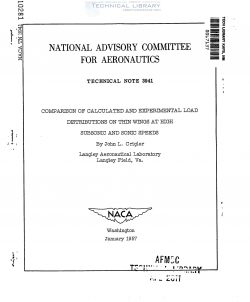naca-tn-3941
- Version
- 42 Downloads
- 1.53 MB File Size
- 1 File Count
- January 29, 2017 Create Date
- January 29, 2017 Last Updated
National Advisory Committee for Aeronautics, Technical Notes - Comparison of Calculated and Experimental Load Distributions on Thin Wings at High Subsonic and Sonic Speeds

A method for calculating the aerodynamic loading on a wing in combi-
nation with a body is presented. The method is similar to that used by
Falkner for wings in incompressible flow, except that the present method
directly relates the downwash velocity to the lift on the wing in a com-
pressible medium for any Mach number. '
Calculated results are compared with experimental data for two wing-
body configLu'ations throughout a range of Mach number up to 1.0. Both
wings were swept back 11-50 with an aspect ratio of A. One of the wings
had a taper ratio of 0.6 and NACA 65A006 airfoil sections and was tested
with and without twist. The other wing had a taper ratio of 0.15 and
NACA 6144x206, a = 0 airfoil section at the fuselage boundary, fairing to
an NACA @9203, a = 0.8 (modified) airfoil section at the midspan. The
sections of the wing from the midspan to the tip were NACA 6114.203, a. = 0.8
(modified).
The magnitude and the distribution of spanwise loading of the cal-
culated data are in good agreement with experiment up to a Mach number
of 0.95, and for the highly tapered wing the agreement of the calculated
spanwise load distribution with the experimental distribution is still ‘
good up to a Mach number of 0.98.
hi recent years the calculation of span loading on wings for wing-
body combinations has become of increasing importance for airplane
designers. The great number of airplanes with widely different types of
plan form, designed to fly at high Mach numbers, makes it virtually
impossible to obtain experimental data on the aerodynamic characteristics
over the complete flight range for all wings of interest. Thus, there
has been considerable interest in calculation methods, particularly in
the calculation of the distribution, or shape, of the span loading.
The purpose of this report is to show to what degree span load
distributions as calculated by linear theory agree with experimentally
measured span load distributions, particularly in the speed ranges
approaching sonic conditions. In making this study, calculated span
load distributions are compared with experimentally measured values for
some thin wings for wing-body combinations throughout a Mach number range
up to M0 = 1.0.
| File | Action |
|---|---|
| naca-tn-3941 Comparison of Calculated and Experimental Load Distributions on Thin Wings at High Subsonic and Sonic Speeds.pdf | Download |

Comment On This Post